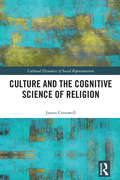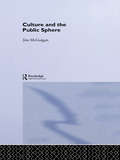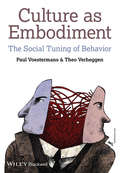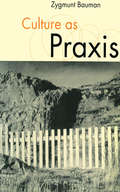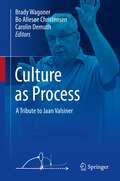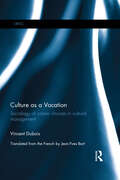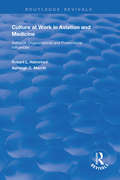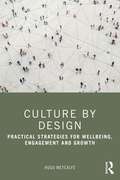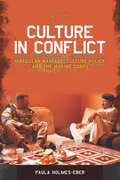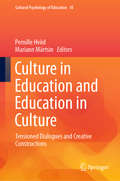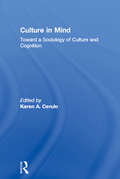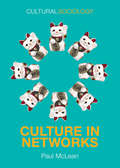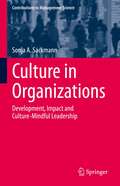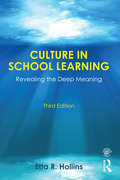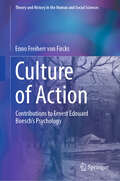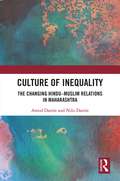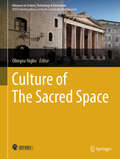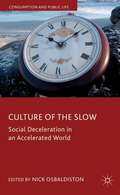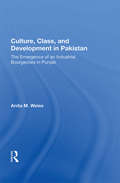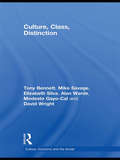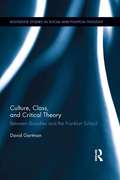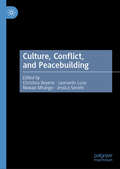- Table View
- List View
Culture and the Cognitive Science of Religion (Cultural Dynamics of Social Representation)
by James CresswellCulture and the Cognitive Science of Religion is the first book to bring together cultural psychology and the cognitive science of religion (CSR). Containing much-needed discussion of how good research should do more than simply follow methodological prescriptions, this thought-provoking and original book outlines the ways in which CSR can be used to study everyday religious belief without sacrificing psychological science. Cresswell’s pragmatist approach expands CSR in a radically new direction. The author shows how language and culture can be integrated within CSR in order to achieve an alternative ontogenetic and phylogenetic approach to cognition, and argues that a view of cognition that is not based on modularity, but on the dynamic connection between an organism and its milieu, can lead to a view of evolution that makes much more room for the constitutive role of culture in cognition. As a provocative attempt to persuade researchers to engage with religious communities more directly, the book should be essential reading for academics, researchers and postgraduate students, as well as psychologists interested in the cognitive science of religion, theological anthropology, religious studies and cultural anthropology.
Culture and the Public Sphere
by Jim McGuigan Dr Jim McguiganJim McGuigan discusses cultural policy as a manifestation of cultural politics in the widest sense. Illustrating his case with examples from recent cultural policy initiatives in Britain, the United States and Australia, he looks at:* The rise of market reasoning in arts administration* Urban regeneration and the arts* Heritage tourism* Race, identity and cultural citizenship* Censorship and moral regulation* The role of computer-mediated communication in democratic discourse
Culture as Embodiment
by Paul Voestermans Theo VerheggenCulture as Embodiment utilizes recent insights in psychology, cognitive, and affective science to reveal the cultural patterning of behavior in group-related practices.Applies the best of the behavioural sciences to contemporary issues of behavioural cross-fertilization in global exchangePresents an original theory to be used in the gender and integration debates, about what the acceptance of newcomers from different cultural backgrounds really entailsPresents a theory that is also applicable to youth culture and the split in modern society between underclass, modal class, and the eliteContains an original approach to the persistence of religion, and relates religious thought to the cognitive capacity of generic belief
Culture as Praxis (Published in association with Theory, Culture & Society)
by Zygmunt BaumanIn this major work, Zygmunt Bauman seeks to classify the meanings of culture. He distinguishes between culture as a concept, culture as a structure and culture as praxis and analyzes the different ways in which culture has been used in each of these settings. For Bauman, culture is a living, changing aspect of human interaction which must be understood and studied as a universal of human life. At the heart of his approach is the proposition that culture is inherently ambivalent. With a major new introduction to this new edition, this classic work emerges as a crucial link in the development of Bauman's thought. By his own admission, it was the first of his books to grope towards a new kind of social theory, in contrast to the false certainties and gross theorems that dominated much of the post-war period. This is Bauman at his best, at his most subtle and his most searching.
Culture as Process: A Tribute to Jaan Valsiner
by Brady Wagoner Bo Allesøe Christensen Carolin DemuthJaan Valsiner has made numerous contributions to the development of psychology over the last 40 years. He is internationally recognized as a leader and innovator within both developmental psychology and cultural psychology, and has received numerous prizes for his work: the Alexander von Humboldt prize, the Hans Killian prize, and the Outstanding International Psychologist Award from the American Psychological Association. Having taught at Universities in Europe, Asia and north and south America, he is currently Niels Bohr professor at Aalborg University, Denmark. This book is the first to discuss in detail the different sides of Valsiner’s thought, including developmental science, semiotic mediation, cultural transmission, aesthetics, globalization of science, epistemology, methodology and the history of ideas. The book provides an overview, evaluation and extension of Valsiner’s key ideas for the construction of a dynamic cultural psychology, written by his former students and colleagues from around the world.
Culture as a Vocation: Sociology of career choices in cultural management (CRESC)
by Vincent DuboisVocational occupations are attractive not so much for their material rewards as for the prestige and self-fulfillment they confer. They require a strong personal commitment, which can be subjectively experienced in terms of passion and selflessness. The choice of a career in the cultural sector provides a good example of this. What are the terms of this calling? What predisposes individuals to answer it? What are the meanings of such a choice? To answer these questions, this book focuses on would-be cultural managers. By identifying their social patterns, by revealing the resources, expectations and visions of the world they invest in their choice, it sheds new light on these occupations. In these intermediary and indeterminate social positions, family heritages intersect with educational strategies, aspirations of upward mobility with tactics against downward mobility, and social critique with adjustment strategies. Ultimately the study of career choices in cultural management suggests a new take on the analysis of social reproduction and on the embodiment of the new spirit of capitalism. The empirical findings of this research conducted in France are set in a broader comparative perspective, at the European level and with the USA.
Culture at Work in Aviation and Medicine: National, Organizational and Professional Influences (Routledge Revivals)
by Ashleigh C. Merritt Robert L. HelmreichPublished in 1998, culture forms a complex framework of national, organizational, and professional attitudes and values within which groups and individuals function. The reality and strength of culture become salient when we work within a new group and interact with people who have well established norms and values. In this book the authors report the results of their ongoing exploration of the influences of culture in two professions, aviation and medicine. Their focus is on commercial airline pilots and operating room teams. Within these two environments they show the effect of professional, national and organizational cultures of individual attitudes and values and team interaction.
Culture by Design: Practical Strategies for Wellbeing, Engagement and Growth
by Hugo MetcalfeCulture by Design is about shifting focus from solely organisational outcomes and performance, towards organisational culture and wellbeing. It bridges the gap between two key organisational goals: (a) the drive for improving performance, outcomes and staff retention, and (b) strategies to encourage employee wellbeing, motivation and engagement within the workplace. For too long, organisations have focussed on each of these goals individually, with improvements in one area often coming at the expense of the other. This book demonstrates that this does not need to be the case, that what is required is a shift in perspective towards a culture-focussed approach where improved outcomes, performance and engagement are the added bonuses of a happy, connected staff team. You may be familiar with the phrase "Happy bees work harder"; this book demonstrates the fundamental truth in that statement and illustrates that "What is good for the bees is good for the hive".Through practical strategies and real-world examples, this book reveals that the application of evidence-led, self-directed and cost-effective strategies can support any organisation to cultivate the culture they need to encourage the outcomes they want. This book offers a synthesis of theory and practice from organisational and social psychology, neuroscience and systems dynamics, alongside examples of practical tools you can start using today, to offer a roadmap to cultivating a workplace culture that supports the wellbeing and performance of the organisation as a whole.Whether you are an HR director, People Manager, C-Suite Team member or Wellbeing and Culture Lead, this book is relevant to Leaders in organisations of any size. If you are interested in what works when it comes to improving staff wellbeing, how to go about the process of culture change or who makes the tea and why it matters, then this book is for you.
Culture in Conflict: Irregular Warfare, Culture Policy, and the Marine Corps
by Paula Holmes-EberIn response to the irregular warfare challenges facing the U. S. in Iraq and Afghanistan in 2005, General James Mattis#151;then commander of Marine Corps Combat Development Command#151;established a new Marine Corps cultural initiative. The goal was simple: teach Marines to interact successfully with the local population in areas of conflict. The implications, however, were anything but simple: transform an elite military culture founded on the principles of "locate, close with, and destroy the enemy" into a "culturally savvy" Marine Corps. Culture in Conflict: Irregular Warfare, Culture Policy, and the Marine Corps examines the conflicted trajectory of the Marine Corps' efforts to institute a radical culture policy into a military organization that is structured and trained to fight conventional wars. More importantly, however, it is a compelling book about America's shifting military identity in a new world of unconventional warfare.
Culture in Conflict: Irregular Warfare, Culture Policy, and the Marine Corps
by Paula Holmes-EberIn response to the irregular warfare challenges facing the U. S. in Iraq and Afghanistan in 2005, General James Mattis#151;then commander of Marine Corps Combat Development Command#151;established a new Marine Corps cultural initiative. The goal was simple: teach Marines to interact successfully with the local population in areas of conflict. The implications, however, were anything but simple: transform an elite military culture founded on the principles of "locate, close with, and destroy the enemy" into a "culturally savvy" Marine Corps. Culture in Conflict: Irregular Warfare, Culture Policy, and the Marine Corps examines the conflicted trajectory of the Marine Corps' efforts to institute a radical culture policy into a military organization that is structured and trained to fight conventional wars. More importantly, however, it is a compelling book about America's shifting military identity in a new world of unconventional warfare.
Culture in Education and Education in Culture: Tensioned Dialogues and Creative Constructions (Cultural Psychology of Education #10)
by Pernille Hviid Mariann MärtsinIn a world where the global engagement and international dialogue intensifies, some areas of cultivated knowledge suffer from this dialogue and this has consequences for people and communities. We propose education to be such a case. The global dialogue in education tends to be restricted to and mediated by standardized measurements. Such standards are meant to measure qualities of education and of student behavior and create the sought for condition for normative comparability and competition. The obvious drawback is that cultural variability – in local living as well as in education – is rendered irrelevant. Are there alternatives? The book insists on maintaining the discussion about education on a global level, but rather than moving towards homogenization and standardization of education, the attention is drawn towards the potential for learning from creative fits - and misfits - between concrete local cultures, institutional practices and global aims and standards of education. This work brings together a group of educational and developmental researchers and scholars grappling to find culturally informed and sensitive modes of educating people and communities. Case studies and examples from four geographical contexts are being discussed: China, Brazil, Australia and Europe. While being embedded in these local cultures, the authors share a conceptual grounding in cultural developmental theorizing and a vision for a culturally informed globalized perspective on education. As the theme of the book is learning from each other, the volume also includes commentaries from leading scholars in the field of cultural psychology and education.
Culture in Mind: Toward a Sociology of Culture and Cognition
by Karen A. CeruloWhat is thought and how does one come to study and understand it? How does the mind work? Does cognitive science explain all the mysteries of the brain? This collection of fourteen original essays from some of the top sociologists in the country, including Eviatar Zerubavel, Diane Vaughan, Paul Dimaggio and Gary Alan Fine, among others, opens a dialogue between cognitive science and cultural sociology, encouraging a new network of scientific collaboration and stimulating new lines of social scientific research. Rather than considering thought as just an individual act, Culture in Mind considers it in a social and cultural context. Provocatively, this suggests that our thoughts do not function in a vacuum: our minds are not alone. Covering such diverse topics as the nature of evil, the process of storytelling, defining mental illness, and the conceptualizing of the premature baby, these essays offer fresh insights into the functioning of the mind. Leaving the MRI behind, Culture in Mind will uncover the mysteries of how we think.
Culture in Networks: Strategic Interaction And Patronage In Renaissance Florence (Cultural Sociology)
by Paul McLeanToday, interest in networks is growing by leaps and bounds, in both scientific discourse and popular culture. Networks are thought to be everywhere – from the architecture of our brains to global transportation systems. And networks are especially ubiquitous in the social world: they provide us with social support, account for the emergence of new trends and markets, and foster social protest, among other functions. Besides, who among us is not familiar with Facebook, Twitter, or, for that matter, World of Warcraft, among the myriad emerging forms of network-based virtual social interaction? It is common to think of networks simply in structural terms – the architecture of connections among objects, or the circuitry of a system. But social networks in particular are thoroughly interwoven with cultural things, in the form of tastes, norms, cultural products, styles of communication, and much more. What exactly flows through the circuitry of social networks? How are people's identities and cultural practices shaped by network structures? And, conversely, how do people's identities, their beliefs about the social world, and the kinds of messages they send affect the network structures they create? This book is designed to help readers think about how and when culture and social networks systematically penetrate one another, helping to shape each other in significant ways.
Culture in Organizations: Development, Impact and Culture-Mindful Leadership (Contributions to Management Science)
by Sonja A. Sackmann“Culture eats strategy for breakfast”. Peter Drucker’s provocative statement points to the importance of culture for organizations. Depending on its characteristics, culture contributes significantly to the success or failure of for-profit and not-for-profit organizations. Hence, managers and leaders need to have an understanding of this important concept for best results. This book provides relevant knowledge about the concept of culture. This includes its major characteristics and dimensions, the way culture functions and influences both the internal life of an organization and the resulting performance. The book describes the emergence and development of culture over time as well as the formation and influence of subcultures. Even though culture is always present, certain situations call for specific attention such as fast growth or stagnation, strategic alliances, M&As or situations of change. The book describes how to go about understanding and assessing an organization’s culture as a basis for culture change interventions as well as culture-sensitive and culture-mindful management and leadership.
Culture in School Learning: Revealing the Deep Meaning
by Etta R. HollinsChallenging educators to better understand themselves and their students, this text presents a powerful process for developing a teaching perspective that embraces the centrality of culture in school learning. The six-part process covers examining culture, personalizing culture, inquiring about students' cultures and communities, applying knowledge about culture to teaching, formulating theory or a conceptual framework linking culture and school learning, and transforming professional practice to better meet the needs of students from different cultural and experiential backgrounds. All aspects of the process are interrelated and interdependent. Two basic procedures employed in this process are presented: constructing an operational definition of culture that reveals its deep meaning in cognition and learning, and applying the reflective-interpretive-inquiry (RIQ) approach to making linkages between students' cultural and experiential backgrounds and classroom instruction. Pedagogical features in each chapter include Focus Questions; Chapter Summaries; Suggested Learning Experiences, Critical Reading lists. A Companion Website, new for the Third Edition (www.routledge.com/cw/Hollins), provides additional student resources.
Culture in the Domains of Law (Cambridge Studies in Law and Society)
by René ProvostWhat does it mean for courts and other legal institutions to be culturally sensitive? What are the institutional implications and consequences of such an aspiration? To what extent is legal discourse capable of accommodating multiple cultural narratives without losing its claim to normative specificity? And how are we to understand meetings of law and culture in the context of formal and informal legal processes, when demands are made to accommodate cultural difference? The encounter of law and culture is a polycentric relation, but these questions draw our attention to law and legal institutions as one site of encounter warranting further investigation, to map out the place of culture in the domains of law by relying on the insights of law, anthropology, politics, and philosophy. Culture in the Domains of Law seeks to examine and answer these questions, resulting in a richer outlook on both law and culture. Maps the interaction between law and culture in a perspective that is legal but not reductive towards culture. Embraces legal pluralism, resulting in a meeting of law and culture to provide a richer view of both. Offers a transversal outlook on the legal responses to claims of cultural difference in different contexts, enriching our understanding of the nature of law.
Culture of Action: Contributions to Ernest Edouard Boesch’s Psychology (Theory and History in the Human and Social Sciences)
by Enno Freiherr von FircksThe present work introduces innovative research on Symbolic Action Theory, blending theoretical insights with practical applications in psychology. It revisits Ernest Boesch's foundational concepts in Symbolic Action Theory and proposes further advancements in the field. These contributions pave the way for theoretical refinements as well as applied research aimed at enriching clinical, educational, and life-philosophical interventions both within and beyond academic contexts. This book is designed to engage psychologists from diverse specialties while also serving as a valuable resource for practitioners operating in clinical and non-clinical settings alike.
Culture of Inequality: Changing Hindu–Muslim Relations in Maharashtra
by Amod N. Damle Nilu H. DamleThis book offers a historical perspective on the changing Hindu–Muslim relationship in India through a study of syncretic traditions in Kurundwad, Maharashtra. It explores the social and cultural dynamics between the two communities and analyses underlying issues of caste hierarchy, Hindu hegemony, and social dominance. The volume focuses on how the realization of cultural distinctiveness, politics of identity, and the struggle for dominance have played a role in shaping Hindu–Muslim relations in Maharashtra. Through field interviews conducted over three years, the authors contextualise and analyse the nature of cultural hybridity in Kurundwad and how the relationship has changed over the years. The book also focuses on notions of tolerance and inequality and provides insights into the reasons for the growing distinctiveness in cultural and religious identity in Kurundwad since the 1990s, in the aftermath of the demolition of the Babri Masjid and the Shah Banu verdict. The book provides a comprehensive framework for understanding the relationship between Hindus and Muslims in India. It will be of great interest to researchers and students of sociology, politics, modern history, cultural studies, minority studies, and South Asian studies.
Culture of The Sacred Space (Advances in Science, Technology & Innovation)
by Olimpia NiglioThis book highlights the relationship between sacred architecture and tourism, specifically focusing on the role of interior design strategies. It explores how the interior design of sacred spaces can influence the tourist experience and shape their perception of these places. The book touches upon elements such as spatial organization, symbolism, material selection, lighting, and acoustics, all of which contribute to creating a meaningful and immersive environment for visitors. It explores the architectural design, ideological motivations, and the historical context surrounding the palace's construction. The book also addresses the eventual abandonment of the project and its transformation of their uses, reflecting on the complexities of realizing utopian visions in architecture. It examines how the sanctuary's architectural design and spatial arrangement interact with the surrounding landscape, including elements such as topography, vegetation, and water features. Moreover, it focuses on the interior design and explores the symbolism, spatial organization, artistic elements, and spiritual experiences associated with the dome interiors of these structures. The book showcases the historical context, cultural influences, and the evolution of design principles that shaped these remarkable spaces. Also, this book investigates the transition of visionary architectural drawings from the realm of professional architects. Furthermore, it explores how architectural drawings serve as a medium for expressing imaginative and utopian ideas, and how this transition occurs in the context of architectural education.
Culture of the Slow
by Nick OsbaldistonAcross the world, there has been a growing dissatisfaction with the tempo of modern life. Described simply as the 'slow phenomenon', this volume explores this new brand of living that entails not simply slowing down but an embracing of alternative activities that promote meaning, thoughtfulness, engagement and authenticity.
Culture under Cross-Examination: International Justice and the Special Court for Sierra Leone
by Tim KelsallThe international community created the Special Court for Sierra Leone to prosecute those who bore the greatest responsibility for crimes committed during the country's devastating civil war. Tim Kelsall examines some of the challenges posed by the fact that the Court operated in a largely unfamiliar culture, in which the way local people thought about rights, agency and truth-telling sometimes differed radically from the way international lawyers think about these things. By applying an anthro-political perspective to the trials, he unveils a variety of ethical, epistemological, jurisprudential and procedural problems, arguing that although touted as a promising hybrid, the Court failed in crucial ways to adapt to the local culture concerned. Culture matters, and international justice requires a more dialogical, multicultural approach.
Culture, Class, And Development In Pakistan: The Emergence Of An Industrial Bourgeoisie In Punjab
by Anita M. WeissThis book is concerned with social change in Pakistan, particularly the relationship between indigenous sociocultural orientations, the development process, and the rise of a new middle-level entrepreneurial class in the Punjab.
Culture, Class, Distinction (CRESC)
by David Wright Tony Bennett Mike Savage Alan Warde Elizabeth Bortolaia Silva Modesto Gayo-CalChoice Recommended Title, February 2010 Culture, Class, Distinction is major contribution to international debates regarding the role of cultural capital in relation to modern forms of inequality. Drawing on a national study of the organisation of cultural practices in contemporary Britain, the authors review Bourdieu’s classic study of the relationships between culture and class in the light of subsequent debates. In doing so they re-appraise the relationships between class, gender and ethnicity, music, film, television, literary, and arts consumption, the organisation of sporting and culinary practices, and practices of bodily and self maintenance. As the most comprehensive account to date of the varied interpretations of cultural capital that have been developed in the wake of Bourdieu’s work, Culture, Class, Distinction offers the first systematic assessment of the relationships between cultural practice and the social divisions of class, gender and ethnicity in contemporary Britain. It is essential reading for anyone interested in the relationships between culture and society.
Culture, Class, and Critical Theory: Between Bourdieu and the Frankfurt School (Routledge Studies in Social and Political Thought #78)
by David GartmanCulture, Class, and Critical Theory develops a theory of culture that explains how ideas create and legitimate class inequalities in modern society. This theory is developed through a critique and comparison of the powerful ideas on culture offered by Pierre Bourdieu and the Frankfurt School thinkers, especially Theodor Adorno. These ideas are illuminated and criticized through the development of two empirical cases on which Gartman has published extensively, automobile design and architecture. Bourdieu and the Frankfurt School postulate opposite theories of the cultural legitimation of class inequalities. Bourdieu argues that the culture of modern society is a class culture, a ranked diversity of beliefs and tastes corresponding to different classes. The cultural beliefs and practices of the dominant class are arbitrarily defined as superior, thus legitimating its greater share of social resources. By contrast, the thinkers of the Frankfurt School conceive of modern culture as a mass culture, a leveled homogeneity in which the ideas and tastes shared by all classes disguises real class inequalities. This creates the illusion of an egalitarian democracy that prevents inequalities from being contested. Through an empirical assessment of the theories against the cases, Gartman reveals that both are correct, but for different parts of modern culture. These parts combine to provide a strong legitimation of class inequalities.
Culture, Conflict, and Peacebuilding
by Leonardo Luna Jessica Senehi Christina Beyene Nkwazi MhangoThis book explores the complexity, multiplicity, intersectionality, and dynamism of cultures in connection with critical and emancipatory peacebuilding. It includes diverse voices to emphasize local and everyday peacebuilding within a narrative that links the personal to the political. It is a valuable resource for students, educators, and practitioners in peace and conflict studies, cultural studies, sociology, and related disciplines.
